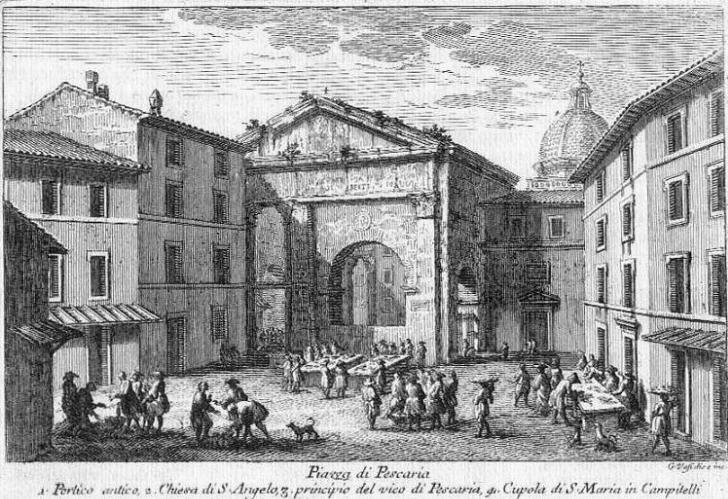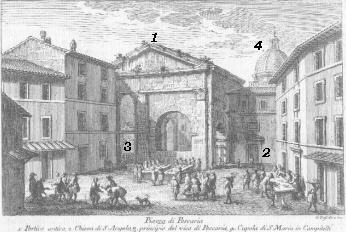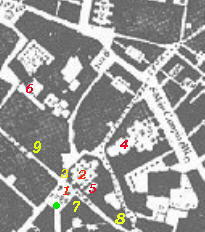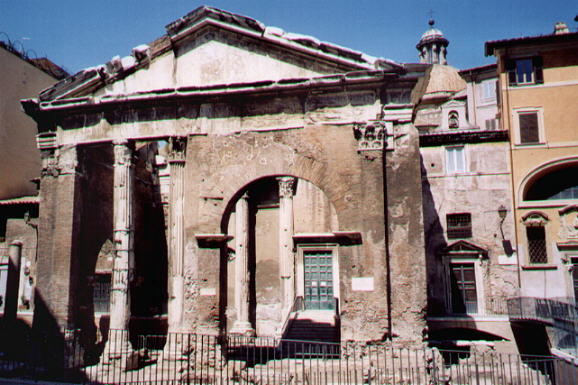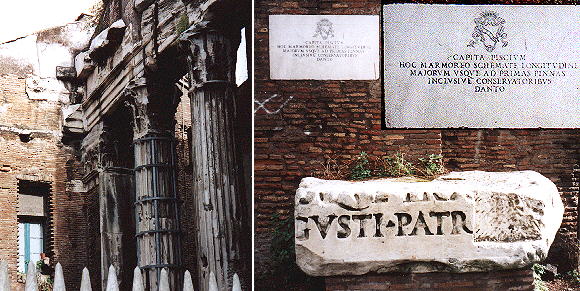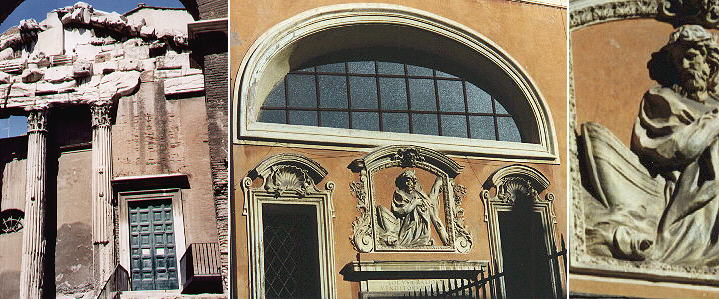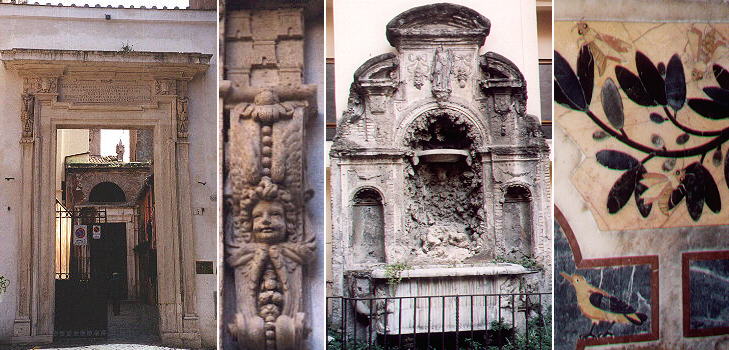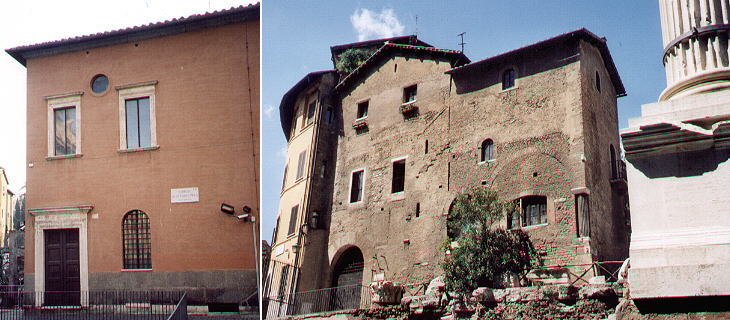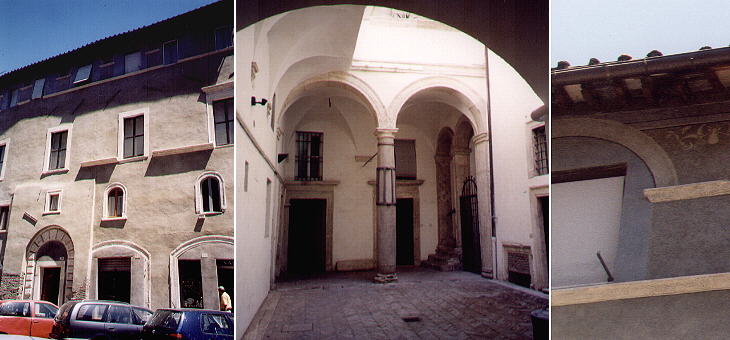

Piazza di Pescaria (Book
2) (Day
5) (View C8) (Rione Sant'Angelo)
In this page:
The plate by Giuseppe Vasi
Today's view
Everyday life
S. Angelo in Pescheria
S. Ambrogio alla Massima
Casa dei Vailati e Albergo della Catena
Case dei Fabi
The Plate (No. 28 - ii)
Vasi leads us to see the fish market of Rome. Pesce=fish hence pescaria=fishery.
But before being a fish market the area was rich in temples. What is left
is the Portico d'Ottavia, the sister of Augustus. The view is taken from the green dot in the small 1748 map here below.
In the description below the plate Vasi made reference to: 1) Ancient Portico;
2) S. Angelo; 3) Vico (small alley) di Pescaria; 4) Dome of S. Maria in Campitelli. 4) is shown in another page.
The small map shows also: 5) S. Andrea dei Pescivendoli; 6) S. Ambrogio della Massima; 7) Casa dei Vailati; 8) Albergo della Catena; 9) Casa dei Fabi.
Today
The old temple is still only partly excavated. We have here one of
the most interesting examples in Rome of how churches and houses were built
using existing ruins of temples.
Everyday
Life
The window of the house has a view on the rear colonnade of the Portico.
A large fragment of the temple was used for many years as a yardstick for
measuring the size of the fish.
S.
Angelo in Pescheria
Portico d'Ottavia hides the entrance to the church of S. Angelo in
Pescheria. A chapel was separated from this church in the XVIIIth century
to form the little church of S. Andrea dei Pescivendoli (St. Andrew of the Fishmongers) which was paid
for by the Fishmongers' Guild (click here for a list of churches belonging to a guild).
S.
Ambrogio alla
Massima
The monastery of S.Ambrogio is located behind Portico d'Ottavia and
part of it is today used for other purposes. This explains why the fine
1626 portal built at the expense of the abbess Beatrice de Torres leads
today to a small warehouse of the municipal street cleansing services. A gate on the left leads to a courtyard
with a small nymphaeum and to the church. The church, although largely modernized, retains some interesting
memories of its past in particular
the decoration of the altars with the bees of the Barberini family.
Casa
dei Vailati e
Albergo della Catena
The print by Vasi shows on the right side a rather anonymous house. In 1930 it was partially demolished to
highlight its original Renaissance design. It belonged to the Vailati (or Vallati) family.
The excavations
of the area between Portico d'Ottavia and Teatro di Marcello have isolated two
medieval buildings where once was located Albergo della Catena an inn which catered for the merchants
who came from the countryside to do business in Piazza Montanara.
Case
dei Fabi
The northern side of the street leading from Piazza di Pescheria to
Piazza Giudia is flanked by Renaissance houses.
A recent restoration has given emphasis to the original architectural design of two buildings belonging to the Fabi family,
who pretended to descend from the Gens Fabia a family who played a major role in Ancient Rome during the Republic.
The buildings were embellished by a decorated loggia, closed at a later stage to obtain some more rooms.
Excerpts from Giuseppe Vasi 1761 Itinerary related to this page:
Chiesa di s. Michele Arcangelo in Pescheria
Le anticaglie, che qui si vedono, sono credute del portico di Giunone, il quale essendosi abbruciato,
fu ristaurato da Settimio Severo, Marco Aurelio, e Antonino Pio; ora per il sito basso, ed umido
quì fa capo ogni sorta di pesce, e poi si sparge all'altre piazze. La chiesa di san Michele Arcangelo,
che si vede fra quelle rovine, fu eretta da Bonifazio II., e fu detta in Summo Circi, cioè come spiegano,
in capite Circi Flaminii, la quale poi per la demolizione del Circo rimasta desolata, fu riedificata
quivi forse da Stefano III. che fu nell'anno 752. il quale l'arricchì di alcuni corpi di ss. Martiri levati
da una chiesa, che era sulla strada di Tivoli, e furono li ss. Getulio, e Sinforosa sua moglie con
sette loro figliuoli, e però si vedono in essa più memorie antiche, che ornamenti moderni.
Chiesa e Monastero di s. Ambrogio della Massima
Entrando poi nel vicolo accanto alla fontana, che sembra non aver riuscita, si trova questa antichissima
chiesa insieme col monastero delle monache Benedettine. Fu già quivi un'antica chiesa dedicata a
s. Stefano, ed appresso fuvvi la casa di s. Ambrogio arcivescovo di Milano, la quale essendo dalla
sua sorella ridotta in forma di monastero, lo fece poi erede di tutto il suo avere. Indi Celestino I. nell'
anno 432. avendo avuto nuova, che il Concilio Efesino aveva dichiarato, che la ss. Vergine era Madre di
Dio, aggiunse alla salutazione Angelica quelle parole: Santa Maria Mater Dei, ed in onore di lei edificò
alcune chiese, fra le quali fece questa di nuovo, e la dedicò alla ss. Vergine Madre di Dio, e fu detta
in Ambrogio. L'anno poi 1606. fu nuovamente fatta da D. Beatrice Torres coll'ajuto però del Cardinale
suo fratello Arcivescovo di Monreale, e fu ornata di belli altari con pitture, e marmi. La statua di
s. Ambrogio nel primo altare a destra è di Orfeo Rufelli fatta sul modello di Francesco Fiammingo;
la deposizione dalla Croce nell'altare, che siegue è del Romanelli, e il quadro sull'altare maggiore, di
Ciro Ferri. Le pitture nella volta sono del Cozza, e quelle nella cappella della Madonna,
del Cav. d'Arpino; il s. Stefano però nell'ultima cappella è opera insigne di Pietro da Cortona.
Credono queste monache di avere nella loro chiesa il corpo di santa Candida; ma non sanno poi se da
Cartagine fosse qui portato, o se ella venne a morire in questo monastero.
|
Next plate in Book 2: Piazza
Giudia
Next step in Day 5 itinerary: Piazza Montanara
Next step in your tour of Rione Sant'Angelo: Teatro di Marcello

Go
to  or to Book
2 or to the Plan
of my site or to my Home
Page on Baroque Rome or to my Home Page on Rome
in the footsteps of an XVIIIth century traveller.
or to Book
2 or to the Plan
of my site or to my Home
Page on Baroque Rome or to my Home Page on Rome
in the footsteps of an XVIIIth century traveller.
|


